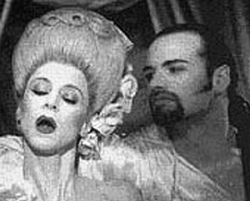

Claudio Monteverdi's libretto L'Orfeo, which tells the tragic story of Orfeo and Euridice's doomed love, was performed Tuesday night in Finney Chapel by the Apollo's Fire Baroque orchestra and Opera Atelier dance company. From the balcony, the sackbuts announced the start of the opera as a procession of dancers marched down the aisle carrying staffs with white feather plumes, bouquets of red roses and wearing exquisite silver and gold dresses.
The prologue, sung by Sandra Simon La Musica, opened the first act with a delicate weave of the Baroque ensemble and Simon's light, lilting tones. Wearing a lyre on her head, La Musica introduced the fable in addition to the theme of how music prevails, represented by a lyre placed at center stage and held by the soloist. Simon's aria exhibited incredible control and an almost choir-boy purity.

The shepherds, played by Marc Molomot and Robert Stafford, an Oberlin Conservatory alumnus, were the most colorful characters of the first two acts. They leaned against each other gracefully during their interludes of commentary. Molomot in particular was able to show great emotion through the finely crafted musical lines, which Stafford did not quite match. However, Molomot's performance as Apollo, Orfeo's father, did not seem large enough for the Sun-god, perhaps because of the score and range of Apollo's aria rather than Stafford's ability.
Jeffrey Strauss, playing Orfeo, began his performance in a duet with Euridice proclaiming their vows of love. Orfeo sung "she is mine forever" in ironic foreshadowing of their doomed love. He did not come across as a particularly strong character until his beautiful and showy aria in the third act in which he tried to charm Caronte, the oarsman of Hades, to let him pass. This aria exhibited his virtuosic mastery of Baroque style, full of glissandos and trills, though it was refined and carefully stylized. Strauss's character finally felt passionate when he realized that he has lost his true love forever. This aria was echoed by a haunting female voice, accompanied by violins and recorders.
The passionate messenger who reported Euridice's death, Sylvia (Meredith Hall), was expressive not only in her voice, but also through her graceful movements. Her pathetic crumble onto the floor by the lyre exhibited the desperation of the scene. In contrast, Orfeo's pose was stiff and statuesque with his hands covering his turned face, emphasized by the identical stance of the dancers in the background. The director's choice to convey his reaction through the postures of the dancers and Orfeo is a reflection of a more reserved style of theater, perhaps influenced by staging characteristic in Greek plays. The choir served a similar purpose to that of the Greek chorus in its restatements of the conflicts and emotions of the scene, though hidden behind the orchestra.
The artistic design was simple: the dancers were the set. The silver and gold ornamented clothes subtly reflected the light and gave the sense of grandeur. The choreography was comprised of playful dances, the kind suitable for nymphs and shepherds, and statuesque poses. The dancers were the focal point of the scene. The psychedelic and tribal aesthetic of the river guards’ and Caronte's costumes seemed out of place next to the blue cloth river and river creatures. The serpentine creatures' bodies were painted on large boards and attached to the dancers in a way that made them sway awkwardly, yet the motion seemed appropriate for movements of bulbous river creatures. However, the small mirrors they held seem to be a metaphorical mystery.
L'Orfeo debuted in 1607 and is considered by many to be the first bona fide opera, complete with musical and textual structural symmetry, an accompanying musical ensemble and an impressive main aria. The returning orchestral theme, masterfully directed by Jeannette Sorrell (who also served as organist and harpsichordist) evoked the playfulness of the nymph dance of the first act and the sorrow of the developing tragedy. Monteverdi's whimsical "Favola in Musica" "fable in music" was a pleasant change from the heavy and robust operas more commonly performed, and it was nice to see an Oberlin graduate on stage.
Tragedy Set on Fire: The Apollo's Fire Baroque Orchestra performed with the Opera Atelier Dance Company in the classic tragedy of Orfeo and Euridice. (photo courtesy Oberlin Online)
Copyright © 2000, The Oberlin Review.
Volume 128, Number 14, February 18, 2000
Contact us with your comments and suggestions.